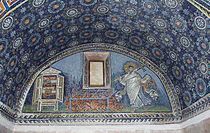Mausoleum of Galla Placidia
 |
|
|
|
The Mausoleum of Galla Placidia is a Roman building in Ravenna, Italy. It was listed with seven other structures in Ravenna in the World Heritage List in 1996. The UNESCO experts describe it as "the earliest and best preserved of all mosaic monuments, and at the same time one of the most artistically perfect".
The building was formerly the oratory of the Church of the Holy Cross and now contains three sarcophagi. The largest sarcophagus was thought to contain the remains of Galla Placidia (died 450), daughter of the Roman Emperor Theodosius I. Her embalmed body was reportedly deposited there in a sitting position, clothed with the imperial mantle. In 1577, however, the contents of the sarcophagus were accidentally burned. The sarcophagus to the right is attributed to Galla's son, Emperor Valentinian III, or to her brother, Emperor Honorius. The one on the left is attributed to her husband, Emperor Constantius III.
The building is not currently used as a mausoleum. It is unknown what the building was intended for when it was built. The most common story is that the structure was built by Galla Placidia, who was a well-known patron of the arts, to be used as a mausoleum for her and her family. There seems to be no evidence to prove or disprove Galla’s connection to the building. The mausoleum was once connected to the narthex of Santa Croce, the church for the imperial palace, built in 417 but now in ruins. Santa Croce was one of the first buildings commissioned by Galla. The floor has been raised by five feet since the fifth century in order to remain above the rising water along the upper Adriatic coast.
Mosaics cover the walls of the vault, the lunettes and the cupola. The iconographic themes developed in the decorations represent the victory of eternal life over death. The mausoleum is laid out in a cruciform floor plan, with a central dome on pendentives and barrel vaults over the four transepts. The exterior of the dome is enclosed in a square tower that rises above the gabled lateral wings. The brick surface is set with narrow mortar joints and decorated with blind arcades.
...
Wikipedia
